Influence of Policy on Teenage Pregnancy Decision Making
VerifiedAdded on 2023/01/05
|9
|2663
|85
AI Summary
This essay explores the influence of policy on teenage pregnancy decision making, including the role of moral values and risk analysis. It discusses the impact of poverty and social exclusion on decision making and examines the research methodology used. The conclusion highlights the need for further research on the decision-making process in teenage pregnancy.
Contribute Materials
Your contribution can guide someone’s learning journey. Share your
documents today.
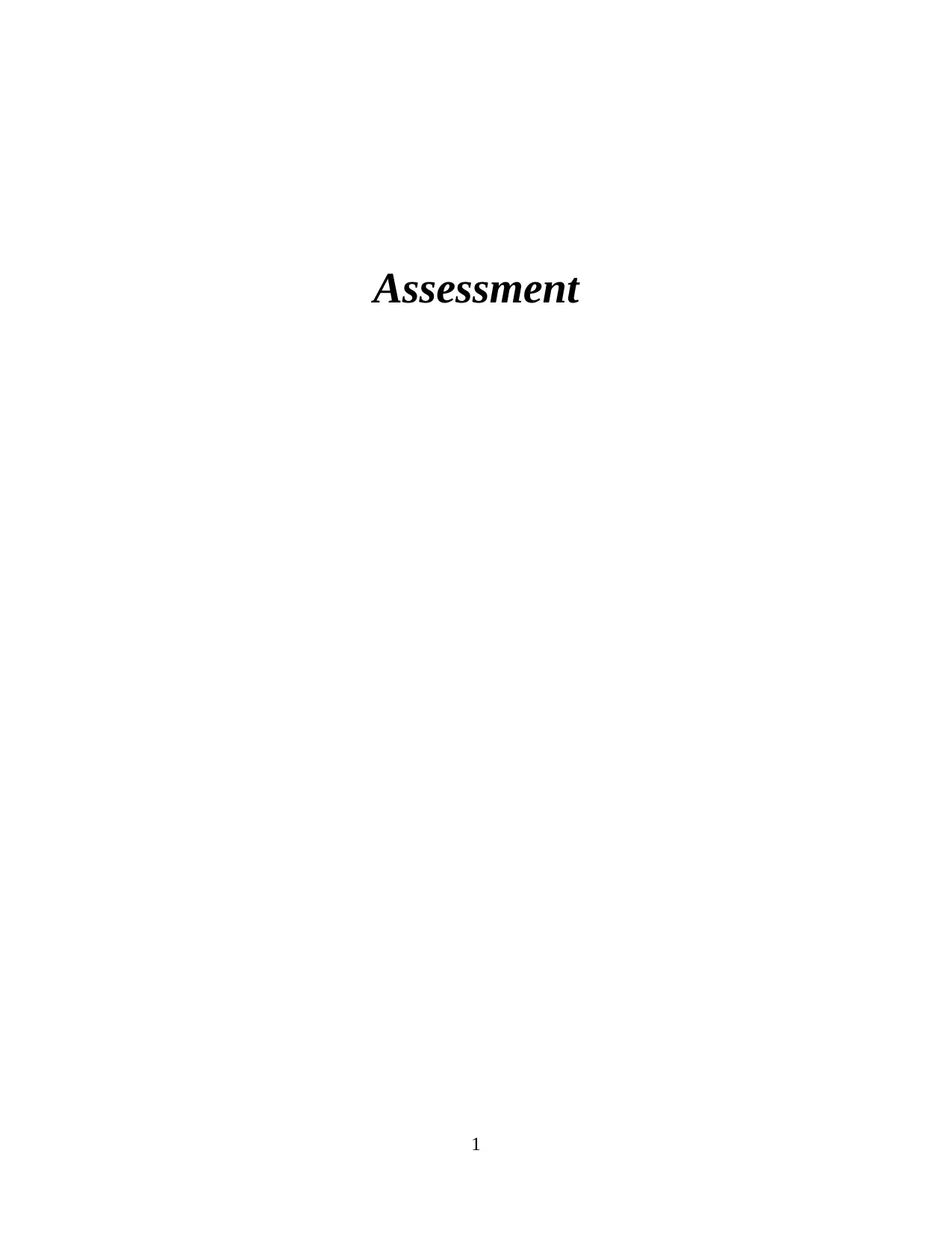
Assessment
1
1
Secure Best Marks with AI Grader
Need help grading? Try our AI Grader for instant feedback on your assignments.
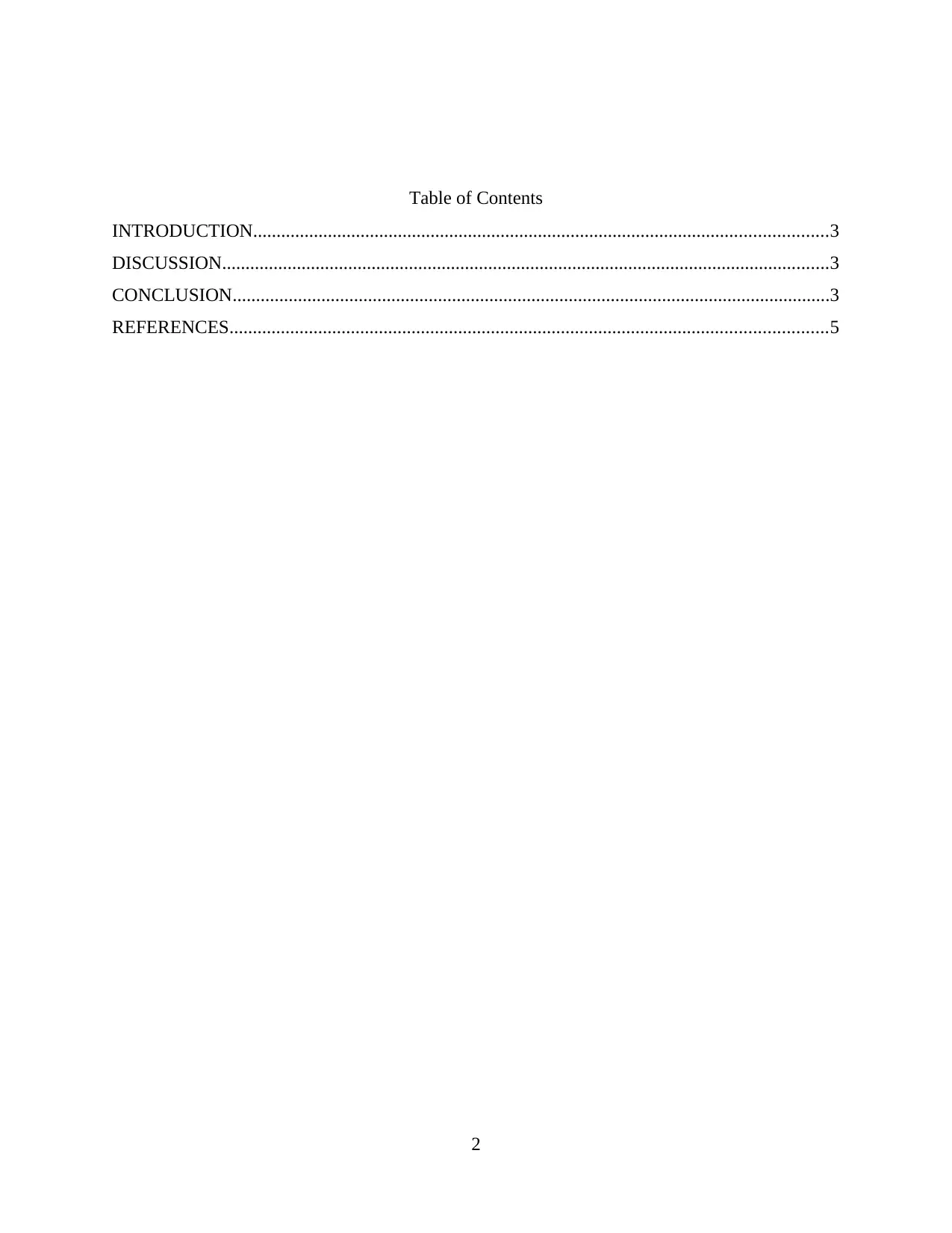
Table of Contents
INTRODUCTION...........................................................................................................................3
DISCUSSION..................................................................................................................................3
CONCLUSION................................................................................................................................3
REFERENCES................................................................................................................................5
2
INTRODUCTION...........................................................................................................................3
DISCUSSION..................................................................................................................................3
CONCLUSION................................................................................................................................3
REFERENCES................................................................................................................................5
2
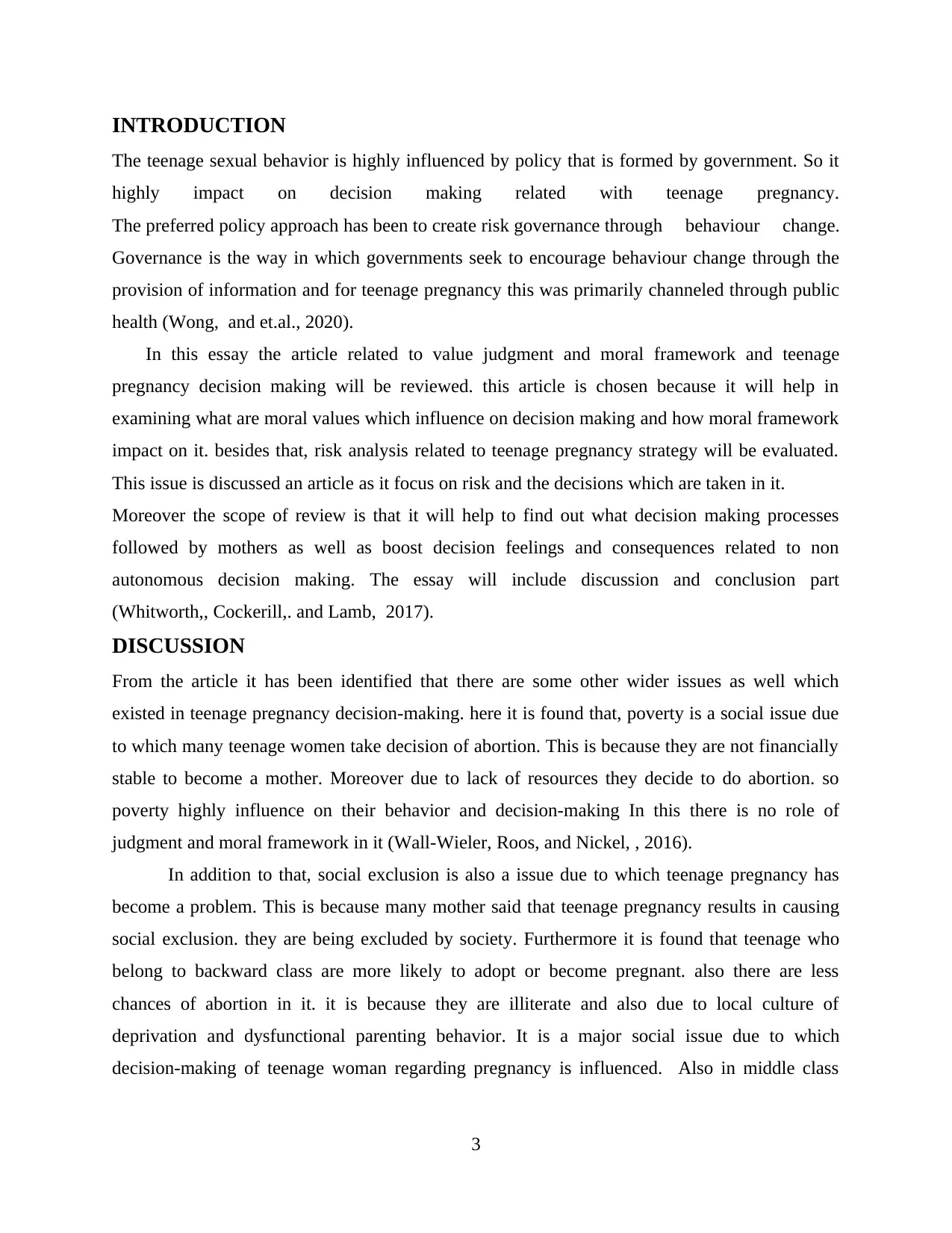
INTRODUCTION
The teenage sexual behavior is highly influenced by policy that is formed by government. So it
highly impact on decision making related with teenage pregnancy.
The preferred policy approach has been to create risk governance through behaviour change.
Governance is the way in which governments seek to encourage behaviour change through the
provision of information and for teenage pregnancy this was primarily channeled through public
health (Wong, and et.al., 2020).
In this essay the article related to value judgment and moral framework and teenage
pregnancy decision making will be reviewed. this article is chosen because it will help in
examining what are moral values which influence on decision making and how moral framework
impact on it. besides that, risk analysis related to teenage pregnancy strategy will be evaluated.
This issue is discussed an article as it focus on risk and the decisions which are taken in it.
Moreover the scope of review is that it will help to find out what decision making processes
followed by mothers as well as boost decision feelings and consequences related to non
autonomous decision making. The essay will include discussion and conclusion part
(Whitworth,, Cockerill,. and Lamb, 2017).
DISCUSSION
From the article it has been identified that there are some other wider issues as well which
existed in teenage pregnancy decision-making. here it is found that, poverty is a social issue due
to which many teenage women take decision of abortion. This is because they are not financially
stable to become a mother. Moreover due to lack of resources they decide to do abortion. so
poverty highly influence on their behavior and decision-making In this there is no role of
judgment and moral framework in it (Wall-Wieler, Roos, and Nickel, , 2016).
In addition to that, social exclusion is also a issue due to which teenage pregnancy has
become a problem. This is because many mother said that teenage pregnancy results in causing
social exclusion. they are being excluded by society. Furthermore it is found that teenage who
belong to backward class are more likely to adopt or become pregnant. also there are less
chances of abortion in it. it is because they are illiterate and also due to local culture of
deprivation and dysfunctional parenting behavior. It is a major social issue due to which
decision-making of teenage woman regarding pregnancy is influenced. Also in middle class
3
The teenage sexual behavior is highly influenced by policy that is formed by government. So it
highly impact on decision making related with teenage pregnancy.
The preferred policy approach has been to create risk governance through behaviour change.
Governance is the way in which governments seek to encourage behaviour change through the
provision of information and for teenage pregnancy this was primarily channeled through public
health (Wong, and et.al., 2020).
In this essay the article related to value judgment and moral framework and teenage
pregnancy decision making will be reviewed. this article is chosen because it will help in
examining what are moral values which influence on decision making and how moral framework
impact on it. besides that, risk analysis related to teenage pregnancy strategy will be evaluated.
This issue is discussed an article as it focus on risk and the decisions which are taken in it.
Moreover the scope of review is that it will help to find out what decision making processes
followed by mothers as well as boost decision feelings and consequences related to non
autonomous decision making. The essay will include discussion and conclusion part
(Whitworth,, Cockerill,. and Lamb, 2017).
DISCUSSION
From the article it has been identified that there are some other wider issues as well which
existed in teenage pregnancy decision-making. here it is found that, poverty is a social issue due
to which many teenage women take decision of abortion. This is because they are not financially
stable to become a mother. Moreover due to lack of resources they decide to do abortion. so
poverty highly influence on their behavior and decision-making In this there is no role of
judgment and moral framework in it (Wall-Wieler, Roos, and Nickel, , 2016).
In addition to that, social exclusion is also a issue due to which teenage pregnancy has
become a problem. This is because many mother said that teenage pregnancy results in causing
social exclusion. they are being excluded by society. Furthermore it is found that teenage who
belong to backward class are more likely to adopt or become pregnant. also there are less
chances of abortion in it. it is because they are illiterate and also due to local culture of
deprivation and dysfunctional parenting behavior. It is a major social issue due to which
decision-making of teenage woman regarding pregnancy is influenced. Also in middle class
3
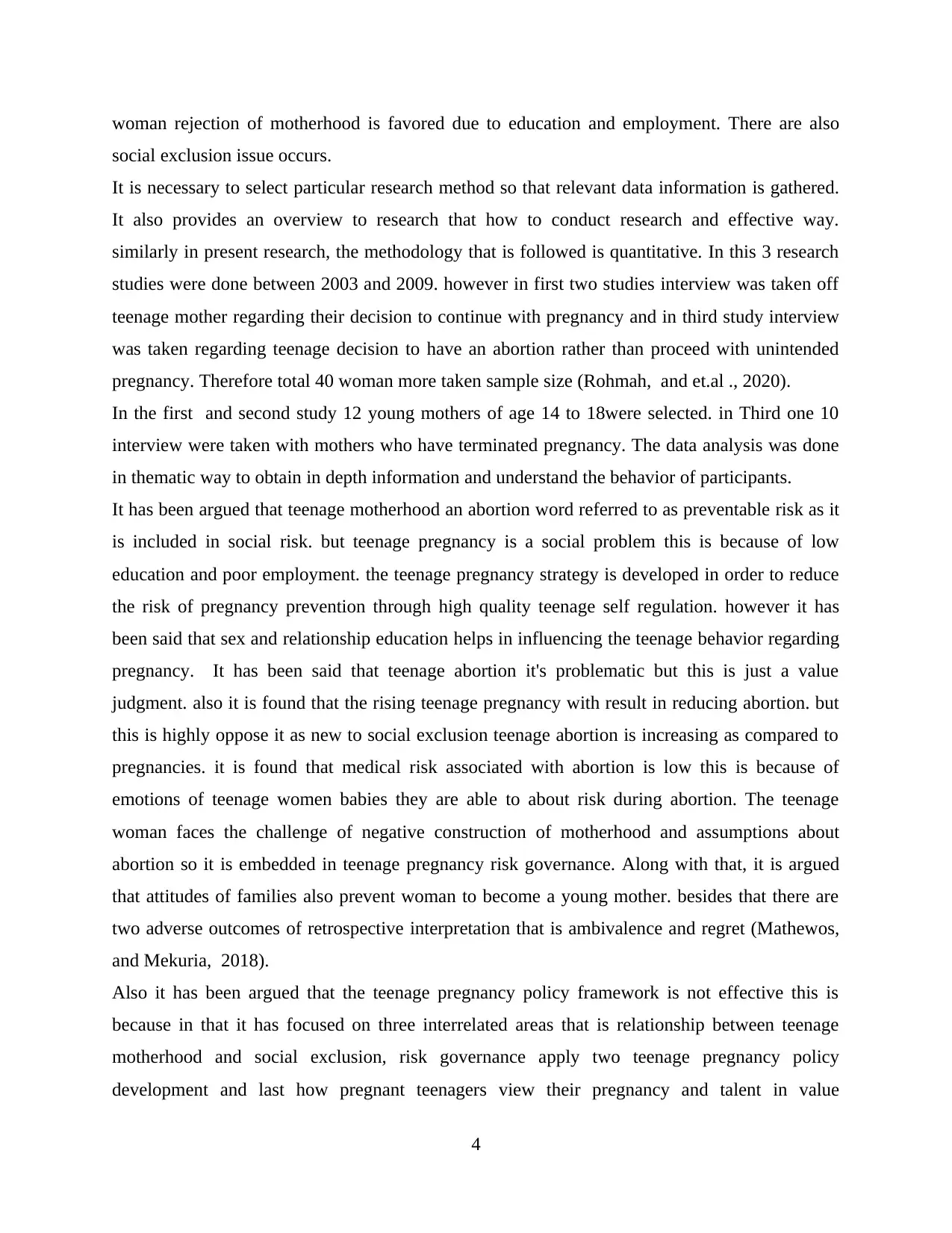
woman rejection of motherhood is favored due to education and employment. There are also
social exclusion issue occurs.
It is necessary to select particular research method so that relevant data information is gathered.
It also provides an overview to research that how to conduct research and effective way.
similarly in present research, the methodology that is followed is quantitative. In this 3 research
studies were done between 2003 and 2009. however in first two studies interview was taken off
teenage mother regarding their decision to continue with pregnancy and in third study interview
was taken regarding teenage decision to have an abortion rather than proceed with unintended
pregnancy. Therefore total 40 woman more taken sample size (Rohmah, and et.al ., 2020).
In the first and second study 12 young mothers of age 14 to 18were selected. in Third one 10
interview were taken with mothers who have terminated pregnancy. The data analysis was done
in thematic way to obtain in depth information and understand the behavior of participants.
It has been argued that teenage motherhood an abortion word referred to as preventable risk as it
is included in social risk. but teenage pregnancy is a social problem this is because of low
education and poor employment. the teenage pregnancy strategy is developed in order to reduce
the risk of pregnancy prevention through high quality teenage self regulation. however it has
been said that sex and relationship education helps in influencing the teenage behavior regarding
pregnancy. It has been said that teenage abortion it's problematic but this is just a value
judgment. also it is found that the rising teenage pregnancy with result in reducing abortion. but
this is highly oppose it as new to social exclusion teenage abortion is increasing as compared to
pregnancies. it is found that medical risk associated with abortion is low this is because of
emotions of teenage women babies they are able to about risk during abortion. The teenage
woman faces the challenge of negative construction of motherhood and assumptions about
abortion so it is embedded in teenage pregnancy risk governance. Along with that, it is argued
that attitudes of families also prevent woman to become a young mother. besides that there are
two adverse outcomes of retrospective interpretation that is ambivalence and regret (Mathewos,
and Mekuria, 2018).
Also it has been argued that the teenage pregnancy policy framework is not effective this is
because in that it has focused on three interrelated areas that is relationship between teenage
motherhood and social exclusion, risk governance apply two teenage pregnancy policy
development and last how pregnant teenagers view their pregnancy and talent in value
4
social exclusion issue occurs.
It is necessary to select particular research method so that relevant data information is gathered.
It also provides an overview to research that how to conduct research and effective way.
similarly in present research, the methodology that is followed is quantitative. In this 3 research
studies were done between 2003 and 2009. however in first two studies interview was taken off
teenage mother regarding their decision to continue with pregnancy and in third study interview
was taken regarding teenage decision to have an abortion rather than proceed with unintended
pregnancy. Therefore total 40 woman more taken sample size (Rohmah, and et.al ., 2020).
In the first and second study 12 young mothers of age 14 to 18were selected. in Third one 10
interview were taken with mothers who have terminated pregnancy. The data analysis was done
in thematic way to obtain in depth information and understand the behavior of participants.
It has been argued that teenage motherhood an abortion word referred to as preventable risk as it
is included in social risk. but teenage pregnancy is a social problem this is because of low
education and poor employment. the teenage pregnancy strategy is developed in order to reduce
the risk of pregnancy prevention through high quality teenage self regulation. however it has
been said that sex and relationship education helps in influencing the teenage behavior regarding
pregnancy. It has been said that teenage abortion it's problematic but this is just a value
judgment. also it is found that the rising teenage pregnancy with result in reducing abortion. but
this is highly oppose it as new to social exclusion teenage abortion is increasing as compared to
pregnancies. it is found that medical risk associated with abortion is low this is because of
emotions of teenage women babies they are able to about risk during abortion. The teenage
woman faces the challenge of negative construction of motherhood and assumptions about
abortion so it is embedded in teenage pregnancy risk governance. Along with that, it is argued
that attitudes of families also prevent woman to become a young mother. besides that there are
two adverse outcomes of retrospective interpretation that is ambivalence and regret (Mathewos,
and Mekuria, 2018).
Also it has been argued that the teenage pregnancy policy framework is not effective this is
because in that it has focused on three interrelated areas that is relationship between teenage
motherhood and social exclusion, risk governance apply two teenage pregnancy policy
development and last how pregnant teenagers view their pregnancy and talent in value
4
Secure Best Marks with AI Grader
Need help grading? Try our AI Grader for instant feedback on your assignments.
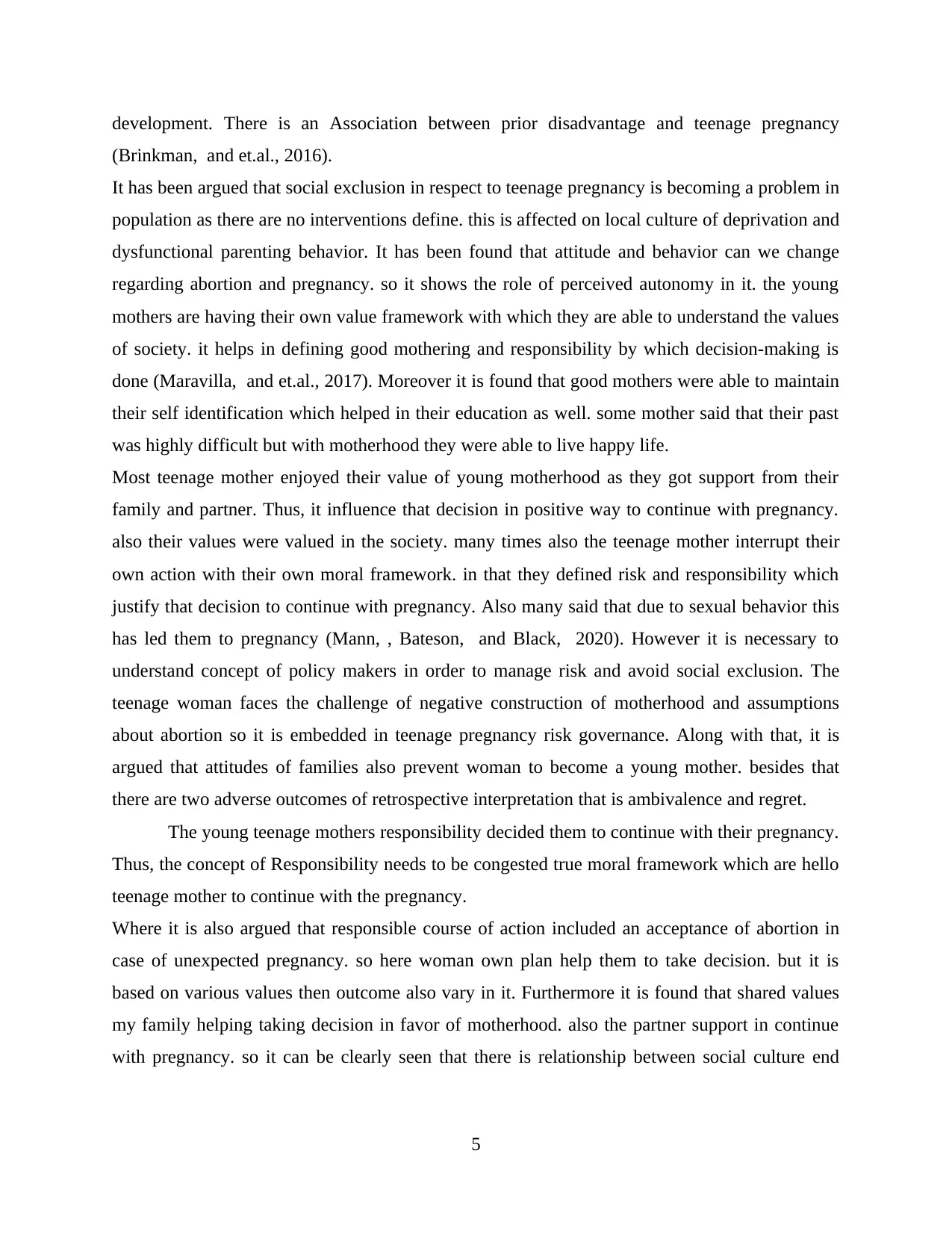
development. There is an Association between prior disadvantage and teenage pregnancy
(Brinkman, and et.al., 2016).
It has been argued that social exclusion in respect to teenage pregnancy is becoming a problem in
population as there are no interventions define. this is affected on local culture of deprivation and
dysfunctional parenting behavior. It has been found that attitude and behavior can we change
regarding abortion and pregnancy. so it shows the role of perceived autonomy in it. the young
mothers are having their own value framework with which they are able to understand the values
of society. it helps in defining good mothering and responsibility by which decision-making is
done (Maravilla, and et.al., 2017). Moreover it is found that good mothers were able to maintain
their self identification which helped in their education as well. some mother said that their past
was highly difficult but with motherhood they were able to live happy life.
Most teenage mother enjoyed their value of young motherhood as they got support from their
family and partner. Thus, it influence that decision in positive way to continue with pregnancy.
also their values were valued in the society. many times also the teenage mother interrupt their
own action with their own moral framework. in that they defined risk and responsibility which
justify that decision to continue with pregnancy. Also many said that due to sexual behavior this
has led them to pregnancy (Mann, , Bateson, and Black, 2020). However it is necessary to
understand concept of policy makers in order to manage risk and avoid social exclusion. The
teenage woman faces the challenge of negative construction of motherhood and assumptions
about abortion so it is embedded in teenage pregnancy risk governance. Along with that, it is
argued that attitudes of families also prevent woman to become a young mother. besides that
there are two adverse outcomes of retrospective interpretation that is ambivalence and regret.
The young teenage mothers responsibility decided them to continue with their pregnancy.
Thus, the concept of Responsibility needs to be congested true moral framework which are hello
teenage mother to continue with the pregnancy.
Where it is also argued that responsible course of action included an acceptance of abortion in
case of unexpected pregnancy. so here woman own plan help them to take decision. but it is
based on various values then outcome also vary in it. Furthermore it is found that shared values
my family helping taking decision in favor of motherhood. also the partner support in continue
with pregnancy. so it can be clearly seen that there is relationship between social culture end
5
(Brinkman, and et.al., 2016).
It has been argued that social exclusion in respect to teenage pregnancy is becoming a problem in
population as there are no interventions define. this is affected on local culture of deprivation and
dysfunctional parenting behavior. It has been found that attitude and behavior can we change
regarding abortion and pregnancy. so it shows the role of perceived autonomy in it. the young
mothers are having their own value framework with which they are able to understand the values
of society. it helps in defining good mothering and responsibility by which decision-making is
done (Maravilla, and et.al., 2017). Moreover it is found that good mothers were able to maintain
their self identification which helped in their education as well. some mother said that their past
was highly difficult but with motherhood they were able to live happy life.
Most teenage mother enjoyed their value of young motherhood as they got support from their
family and partner. Thus, it influence that decision in positive way to continue with pregnancy.
also their values were valued in the society. many times also the teenage mother interrupt their
own action with their own moral framework. in that they defined risk and responsibility which
justify that decision to continue with pregnancy. Also many said that due to sexual behavior this
has led them to pregnancy (Mann, , Bateson, and Black, 2020). However it is necessary to
understand concept of policy makers in order to manage risk and avoid social exclusion. The
teenage woman faces the challenge of negative construction of motherhood and assumptions
about abortion so it is embedded in teenage pregnancy risk governance. Along with that, it is
argued that attitudes of families also prevent woman to become a young mother. besides that
there are two adverse outcomes of retrospective interpretation that is ambivalence and regret.
The young teenage mothers responsibility decided them to continue with their pregnancy.
Thus, the concept of Responsibility needs to be congested true moral framework which are hello
teenage mother to continue with the pregnancy.
Where it is also argued that responsible course of action included an acceptance of abortion in
case of unexpected pregnancy. so here woman own plan help them to take decision. but it is
based on various values then outcome also vary in it. Furthermore it is found that shared values
my family helping taking decision in favor of motherhood. also the partner support in continue
with pregnancy. so it can be clearly seen that there is relationship between social culture end
5
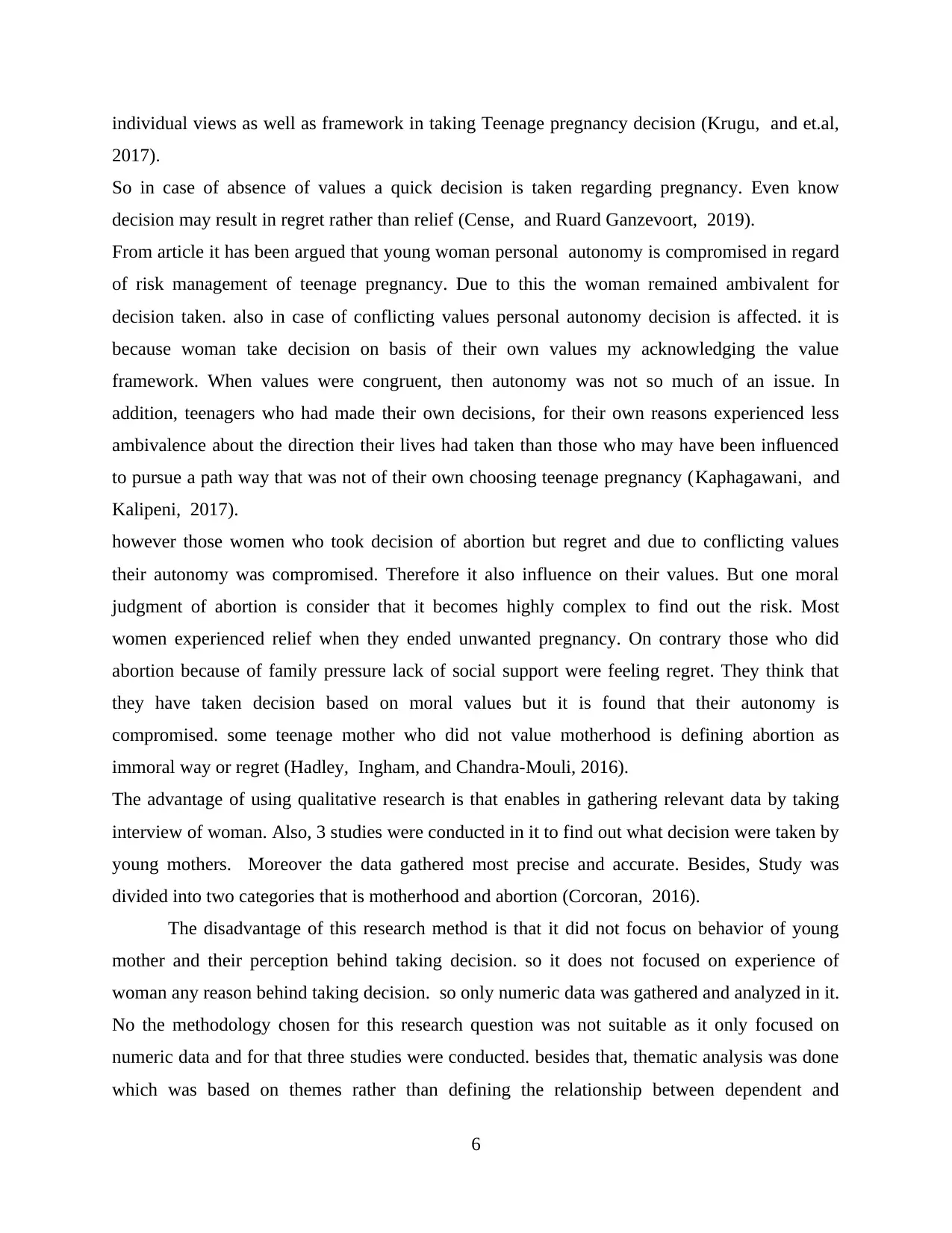
individual views as well as framework in taking Teenage pregnancy decision (Krugu, and et.al,
2017).
So in case of absence of values a quick decision is taken regarding pregnancy. Even know
decision may result in regret rather than relief (Cense, and Ruard Ganzevoort, 2019).
From article it has been argued that young woman personal autonomy is compromised in regard
of risk management of teenage pregnancy. Due to this the woman remained ambivalent for
decision taken. also in case of conflicting values personal autonomy decision is affected. it is
because woman take decision on basis of their own values my acknowledging the value
framework. When values were congruent, then autonomy was not so much of an issue. In
addition, teenagers who had made their own decisions, for their own reasons experienced less
ambivalence about the direction their lives had taken than those who may have been influenced
to pursue a path way that was not of their own choosing teenage pregnancy (Kaphagawani, and
Kalipeni, 2017).
however those women who took decision of abortion but regret and due to conflicting values
their autonomy was compromised. Therefore it also influence on their values. But one moral
judgment of abortion is consider that it becomes highly complex to find out the risk. Most
women experienced relief when they ended unwanted pregnancy. On contrary those who did
abortion because of family pressure lack of social support were feeling regret. They think that
they have taken decision based on moral values but it is found that their autonomy is
compromised. some teenage mother who did not value motherhood is defining abortion as
immoral way or regret (Hadley, Ingham, and Chandra-Mouli, 2016).
The advantage of using qualitative research is that enables in gathering relevant data by taking
interview of woman. Also, 3 studies were conducted in it to find out what decision were taken by
young mothers. Moreover the data gathered most precise and accurate. Besides, Study was
divided into two categories that is motherhood and abortion (Corcoran, 2016).
The disadvantage of this research method is that it did not focus on behavior of young
mother and their perception behind taking decision. so it does not focused on experience of
woman any reason behind taking decision. so only numeric data was gathered and analyzed in it.
No the methodology chosen for this research question was not suitable as it only focused on
numeric data and for that three studies were conducted. besides that, thematic analysis was done
which was based on themes rather than defining the relationship between dependent and
6
2017).
So in case of absence of values a quick decision is taken regarding pregnancy. Even know
decision may result in regret rather than relief (Cense, and Ruard Ganzevoort, 2019).
From article it has been argued that young woman personal autonomy is compromised in regard
of risk management of teenage pregnancy. Due to this the woman remained ambivalent for
decision taken. also in case of conflicting values personal autonomy decision is affected. it is
because woman take decision on basis of their own values my acknowledging the value
framework. When values were congruent, then autonomy was not so much of an issue. In
addition, teenagers who had made their own decisions, for their own reasons experienced less
ambivalence about the direction their lives had taken than those who may have been influenced
to pursue a path way that was not of their own choosing teenage pregnancy (Kaphagawani, and
Kalipeni, 2017).
however those women who took decision of abortion but regret and due to conflicting values
their autonomy was compromised. Therefore it also influence on their values. But one moral
judgment of abortion is consider that it becomes highly complex to find out the risk. Most
women experienced relief when they ended unwanted pregnancy. On contrary those who did
abortion because of family pressure lack of social support were feeling regret. They think that
they have taken decision based on moral values but it is found that their autonomy is
compromised. some teenage mother who did not value motherhood is defining abortion as
immoral way or regret (Hadley, Ingham, and Chandra-Mouli, 2016).
The advantage of using qualitative research is that enables in gathering relevant data by taking
interview of woman. Also, 3 studies were conducted in it to find out what decision were taken by
young mothers. Moreover the data gathered most precise and accurate. Besides, Study was
divided into two categories that is motherhood and abortion (Corcoran, 2016).
The disadvantage of this research method is that it did not focus on behavior of young
mother and their perception behind taking decision. so it does not focused on experience of
woman any reason behind taking decision. so only numeric data was gathered and analyzed in it.
No the methodology chosen for this research question was not suitable as it only focused on
numeric data and for that three studies were conducted. besides that, thematic analysis was done
which was based on themes rather than defining the relationship between dependent and
6
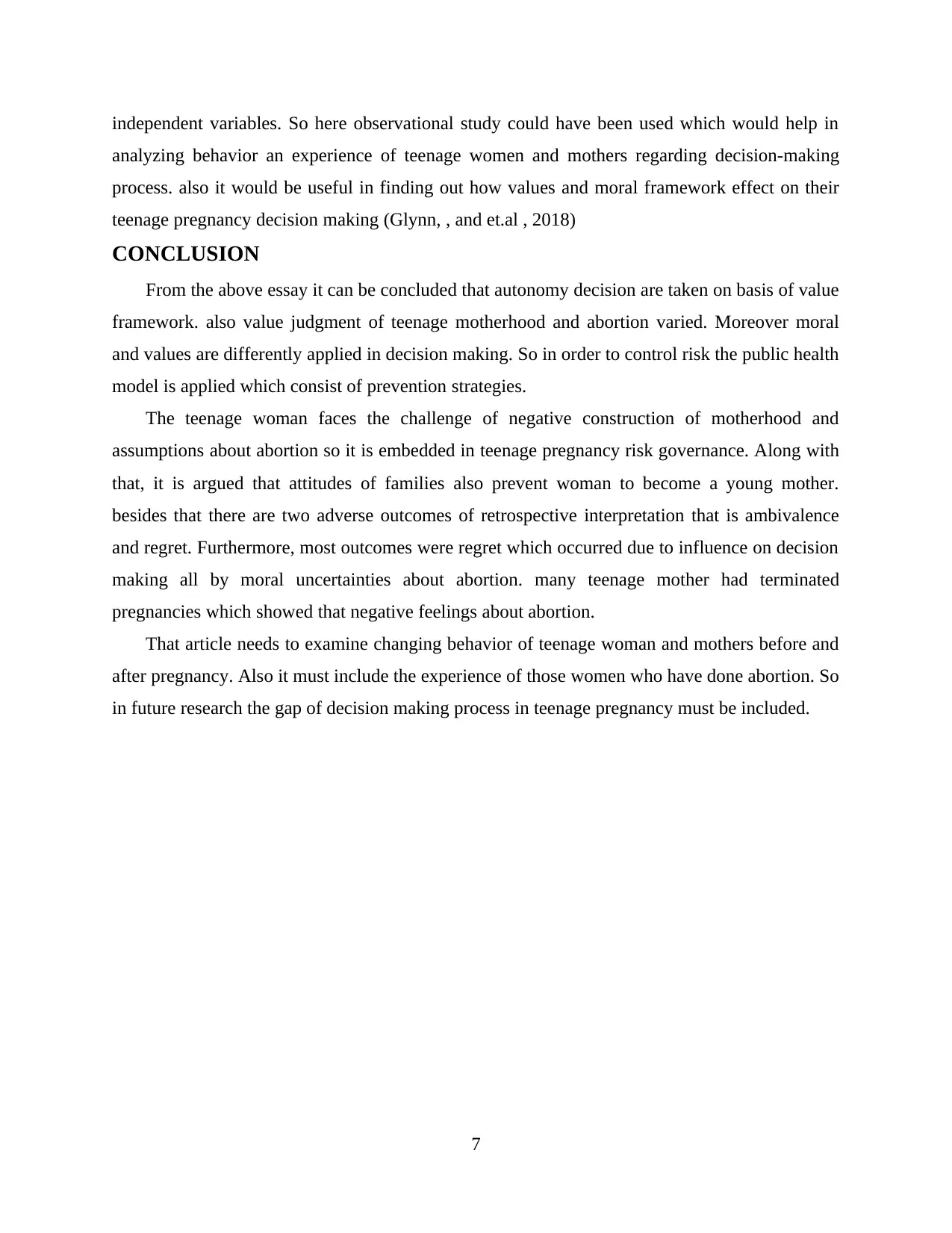
independent variables. So here observational study could have been used which would help in
analyzing behavior an experience of teenage women and mothers regarding decision-making
process. also it would be useful in finding out how values and moral framework effect on their
teenage pregnancy decision making (Glynn, , and et.al , 2018)
CONCLUSION
From the above essay it can be concluded that autonomy decision are taken on basis of value
framework. also value judgment of teenage motherhood and abortion varied. Moreover moral
and values are differently applied in decision making. So in order to control risk the public health
model is applied which consist of prevention strategies.
The teenage woman faces the challenge of negative construction of motherhood and
assumptions about abortion so it is embedded in teenage pregnancy risk governance. Along with
that, it is argued that attitudes of families also prevent woman to become a young mother.
besides that there are two adverse outcomes of retrospective interpretation that is ambivalence
and regret. Furthermore, most outcomes were regret which occurred due to influence on decision
making all by moral uncertainties about abortion. many teenage mother had terminated
pregnancies which showed that negative feelings about abortion.
That article needs to examine changing behavior of teenage woman and mothers before and
after pregnancy. Also it must include the experience of those women who have done abortion. So
in future research the gap of decision making process in teenage pregnancy must be included.
7
analyzing behavior an experience of teenage women and mothers regarding decision-making
process. also it would be useful in finding out how values and moral framework effect on their
teenage pregnancy decision making (Glynn, , and et.al , 2018)
CONCLUSION
From the above essay it can be concluded that autonomy decision are taken on basis of value
framework. also value judgment of teenage motherhood and abortion varied. Moreover moral
and values are differently applied in decision making. So in order to control risk the public health
model is applied which consist of prevention strategies.
The teenage woman faces the challenge of negative construction of motherhood and
assumptions about abortion so it is embedded in teenage pregnancy risk governance. Along with
that, it is argued that attitudes of families also prevent woman to become a young mother.
besides that there are two adverse outcomes of retrospective interpretation that is ambivalence
and regret. Furthermore, most outcomes were regret which occurred due to influence on decision
making all by moral uncertainties about abortion. many teenage mother had terminated
pregnancies which showed that negative feelings about abortion.
That article needs to examine changing behavior of teenage woman and mothers before and
after pregnancy. Also it must include the experience of those women who have done abortion. So
in future research the gap of decision making process in teenage pregnancy must be included.
7
Paraphrase This Document
Need a fresh take? Get an instant paraphrase of this document with our AI Paraphraser

8
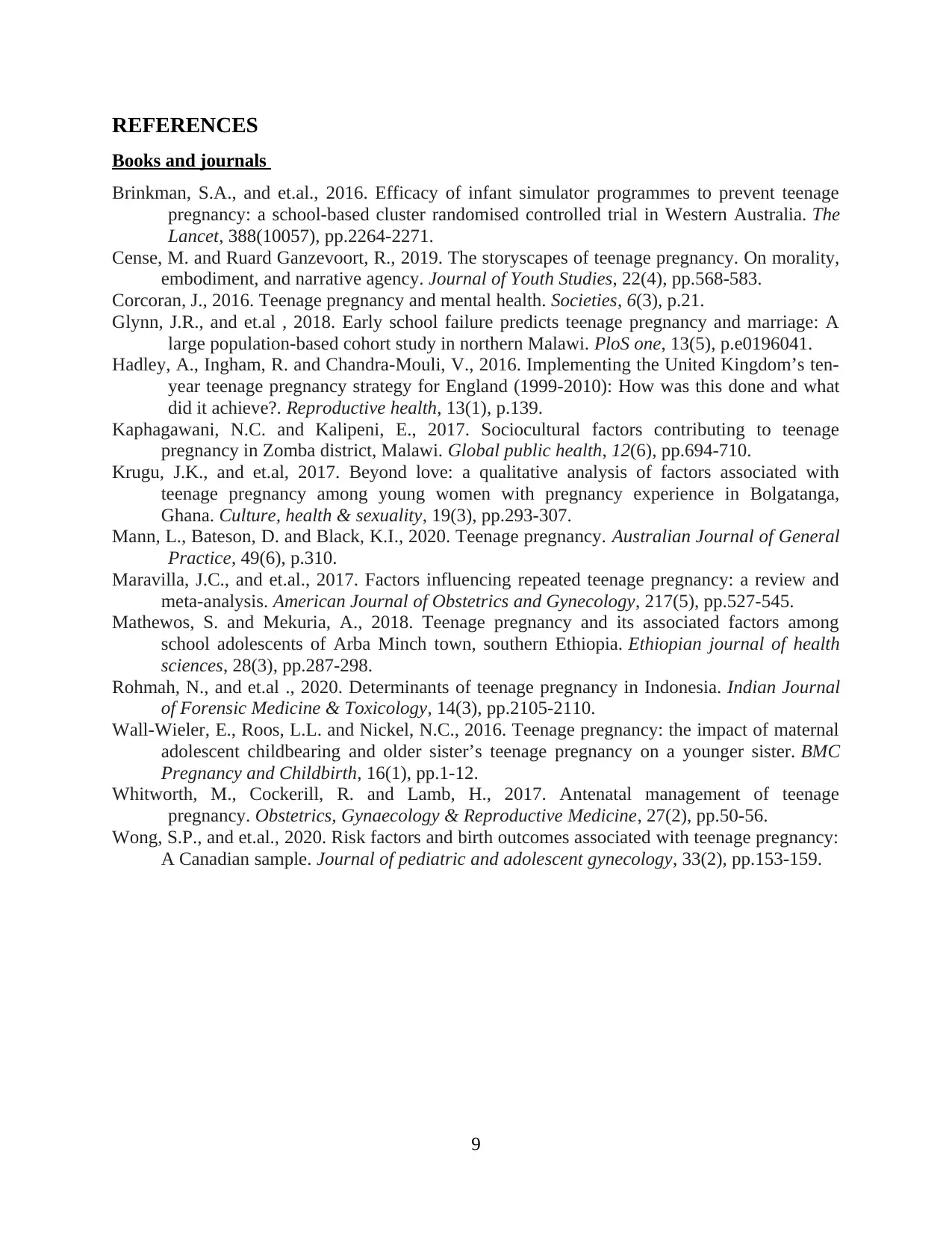
REFERENCES
Books and journals
Brinkman, S.A., and et.al., 2016. Efficacy of infant simulator programmes to prevent teenage
pregnancy: a school-based cluster randomised controlled trial in Western Australia. The
Lancet, 388(10057), pp.2264-2271.
Cense, M. and Ruard Ganzevoort, R., 2019. The storyscapes of teenage pregnancy. On morality,
embodiment, and narrative agency. Journal of Youth Studies, 22(4), pp.568-583.
Corcoran, J., 2016. Teenage pregnancy and mental health. Societies, 6(3), p.21.
Glynn, J.R., and et.al , 2018. Early school failure predicts teenage pregnancy and marriage: A
large population-based cohort study in northern Malawi. PloS one, 13(5), p.e0196041.
Hadley, A., Ingham, R. and Chandra-Mouli, V., 2016. Implementing the United Kingdom’s ten-
year teenage pregnancy strategy for England (1999-2010): How was this done and what
did it achieve?. Reproductive health, 13(1), p.139.
Kaphagawani, N.C. and Kalipeni, E., 2017. Sociocultural factors contributing to teenage
pregnancy in Zomba district, Malawi. Global public health, 12(6), pp.694-710.
Krugu, J.K., and et.al, 2017. Beyond love: a qualitative analysis of factors associated with
teenage pregnancy among young women with pregnancy experience in Bolgatanga,
Ghana. Culture, health & sexuality, 19(3), pp.293-307.
Mann, L., Bateson, D. and Black, K.I., 2020. Teenage pregnancy. Australian Journal of General
Practice, 49(6), p.310.
Maravilla, J.C., and et.al., 2017. Factors influencing repeated teenage pregnancy: a review and
meta-analysis. American Journal of Obstetrics and Gynecology, 217(5), pp.527-545.
Mathewos, S. and Mekuria, A., 2018. Teenage pregnancy and its associated factors among
school adolescents of Arba Minch town, southern Ethiopia. Ethiopian journal of health
sciences, 28(3), pp.287-298.
Rohmah, N., and et.al ., 2020. Determinants of teenage pregnancy in Indonesia. Indian Journal
of Forensic Medicine & Toxicology, 14(3), pp.2105-2110.
Wall-Wieler, E., Roos, L.L. and Nickel, N.C., 2016. Teenage pregnancy: the impact of maternal
adolescent childbearing and older sister’s teenage pregnancy on a younger sister. BMC
Pregnancy and Childbirth, 16(1), pp.1-12.
Whitworth, M., Cockerill, R. and Lamb, H., 2017. Antenatal management of teenage
pregnancy. Obstetrics, Gynaecology & Reproductive Medicine, 27(2), pp.50-56.
Wong, S.P., and et.al., 2020. Risk factors and birth outcomes associated with teenage pregnancy:
A Canadian sample. Journal of pediatric and adolescent gynecology, 33(2), pp.153-159.
9
Books and journals
Brinkman, S.A., and et.al., 2016. Efficacy of infant simulator programmes to prevent teenage
pregnancy: a school-based cluster randomised controlled trial in Western Australia. The
Lancet, 388(10057), pp.2264-2271.
Cense, M. and Ruard Ganzevoort, R., 2019. The storyscapes of teenage pregnancy. On morality,
embodiment, and narrative agency. Journal of Youth Studies, 22(4), pp.568-583.
Corcoran, J., 2016. Teenage pregnancy and mental health. Societies, 6(3), p.21.
Glynn, J.R., and et.al , 2018. Early school failure predicts teenage pregnancy and marriage: A
large population-based cohort study in northern Malawi. PloS one, 13(5), p.e0196041.
Hadley, A., Ingham, R. and Chandra-Mouli, V., 2016. Implementing the United Kingdom’s ten-
year teenage pregnancy strategy for England (1999-2010): How was this done and what
did it achieve?. Reproductive health, 13(1), p.139.
Kaphagawani, N.C. and Kalipeni, E., 2017. Sociocultural factors contributing to teenage
pregnancy in Zomba district, Malawi. Global public health, 12(6), pp.694-710.
Krugu, J.K., and et.al, 2017. Beyond love: a qualitative analysis of factors associated with
teenage pregnancy among young women with pregnancy experience in Bolgatanga,
Ghana. Culture, health & sexuality, 19(3), pp.293-307.
Mann, L., Bateson, D. and Black, K.I., 2020. Teenage pregnancy. Australian Journal of General
Practice, 49(6), p.310.
Maravilla, J.C., and et.al., 2017. Factors influencing repeated teenage pregnancy: a review and
meta-analysis. American Journal of Obstetrics and Gynecology, 217(5), pp.527-545.
Mathewos, S. and Mekuria, A., 2018. Teenage pregnancy and its associated factors among
school adolescents of Arba Minch town, southern Ethiopia. Ethiopian journal of health
sciences, 28(3), pp.287-298.
Rohmah, N., and et.al ., 2020. Determinants of teenage pregnancy in Indonesia. Indian Journal
of Forensic Medicine & Toxicology, 14(3), pp.2105-2110.
Wall-Wieler, E., Roos, L.L. and Nickel, N.C., 2016. Teenage pregnancy: the impact of maternal
adolescent childbearing and older sister’s teenage pregnancy on a younger sister. BMC
Pregnancy and Childbirth, 16(1), pp.1-12.
Whitworth, M., Cockerill, R. and Lamb, H., 2017. Antenatal management of teenage
pregnancy. Obstetrics, Gynaecology & Reproductive Medicine, 27(2), pp.50-56.
Wong, S.P., and et.al., 2020. Risk factors and birth outcomes associated with teenage pregnancy:
A Canadian sample. Journal of pediatric and adolescent gynecology, 33(2), pp.153-159.
9
1 out of 9
Related Documents
Your All-in-One AI-Powered Toolkit for Academic Success.
+13062052269
info@desklib.com
Available 24*7 on WhatsApp / Email
![[object Object]](/_next/static/media/star-bottom.7253800d.svg)
Unlock your academic potential
© 2024 | Zucol Services PVT LTD | All rights reserved.





